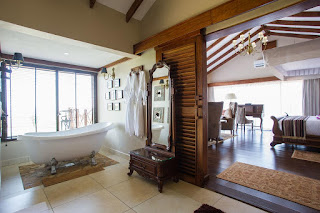Ngorongoro Conservation area is home to a wildlife population of about 25,000 large animals. Mostly ungulates,
alongside the highest density of mammalian predators in Africa including the
densest known population of lion. Ngorongoro harbors a range of endangered
species, such as the Black Rhino, Wild hunting dog and Golden Cat. Ngorongoro hosts one of the largest animal migrations on earth, including over 1 million
wildebeest, 72,000 zebras, and 350,000 Thompson and Grant gazelles.
It
is also home to about 500 species of birds. If you plan for bird watching photographic safaris, include the Ngorongoro conservation area into your safari itinerary. The mix of forests, canyons,
grassland, lakes, and marshes forms an ideal habitat for an enormous variety of
birds. During the rainy season, you can see the arrival of Eurasian migrants at
the open pools. White storks and yellow wagtails mingle with the local inhabitants;
stilts, saddle bill storks, ibis, ruff and various species of duck.
Lesser
flamingos fly in to feed on their breeding grounds at Lake Natron.
Distinctive grassland birds such as ostrich, Kori bustards, and crown cranes
occasionally put on truly magnificent displays.
Accommodation during your wildlife safari tours in the Ngorongoro Conservation area is affordable. There are many accommodation options in Ngorongoro, from Lodges to camping grounds. Safari Lodges vary in standard, usually ranging from 3-star budget lodges, moderate lodges and luxury lodges. Also, tented camp options vary from basic backpackers tents, budget camping safaris, medium luxury tented camps, and upmarket luxury camps. The choice of accommodation depends on your budget and travel style.
Ngorongoro Crater covers an area of 304 sq km and its diameter is 19.5 km, while its depth
is 630km. The Ngorongoro Crater floor is dominated by open grassland and it
has a patch of woodland known as the Lerai forest. This forest provides shelter for
animals such as elephants, eland, monkeys, rare black rhinoceros, Lions, Hippos, and various bird species. The usual safari itineraries from 4 days include a day or 2nights in Ngorongoro crater rim. The must-see attractions in Ngorongoro are Great rift valley and black rhinos.
Ngorongoro-Serengeti -Mara great
migration is the wildlife protected area within the same ecosystem. During
the periods of January through March, the southern Serengeti National Park and
the western part of Ngorongoro Conservation Area (not the Ngorongoro Crater), is inhabited by an
estimated 1.5+ million herds of wildebeest and zebra, which is part of the
greatest migration of wild ungulates (wildebeest and zebra) on earth. From as
early as December the Migration starts to move into the Ngorongoro Conservation
Area. The short grass plains here are rich in nutrition which provides the
herds with the best conditions to raise their newborn. Mid-February is calving the season when approximately 8,000 wildebeest are born every day for a period of
approximately 3 weeks, therefore the area around Lake Ndutu on the western part
of Ngorongoro is the place to be at this time of the year. About 400,000 zebra
and 200,000 gazelles accompany the wildebeest along the way, making a total of
over 2 million migrating animals in Ngorongoro and Serengeti National Park
plains. The best time to do a safari tour to Ngorongoro is December to March. You can book Tanzania safari for 2 days, 3 days or even a day tour and see wildebeest.
Major habitats & land cover types within the ecosystem vary. In the open
grassland plains are dominated by couch grass (Digitaria macroblephara) and
Sporobolus marginatus, Acacia woodland savanna; gallery forest; lowland
woodlands with Commiphora spp., Acacia drepanolobium and A. gerrardii; A. lahai
and A. seyal.
The people of Ngorongoro compose of famous primitive Maasai tribe, Hadzabe, Iraque, etc. Culture
and people of Ngorongoro form one of the important attractions that tourists,
Anthropologists and Archeologists do not dare to miss when visiting Ngorongoro.
Over thousands of years, a succession of the tribes of livestock keepers lived
in and left the area, sometimes driven by other tribal groups.
The
Maasai are instantly identifiable with their toga-like red blanket, ochre-dyed
hairstyle and colorful beaded jewelry. The Maasai have inhabited NCA for about
200 years after forcing out the Datoga. Since then, the Maasai occupied the
area and are living with the environment and wildlife in harmony. Due to their
unique culture and customs, they are among the best known African ethnic group.
The
Maasai are sometimes considered rigid because they have managed to preserve
their traditional way of life and they continue to practice their ancient
customs and ceremonies, which has enabled coexistence with wildlife and the
environment. Maasai proudly practices a traditional cattle-herding lifestyle.
Today there are 88,000 Maasai living in the Conservation area with their herds
of cattle, donkeys, goats, and sheep. During the rainy season, they move to the
grasslands and they spend the dry season in the forest and on the mountain
slopes. The Maasai are allowed to drive their livestock into the crater for
water and salt but settlement is not allowed. Despite their firmness to
preserve their culture, the Maasai are friendly, hospitable and therefore
visitors are welcomed to visit the designated “Maasai bomas” which are
scattered in the Conservation area.
The
Datoga (Barbaig) are the Nilo-Hamitic speaking pastoralists who came to the
area as earlier as 300 years before they were forced to leave out by the
Maasai. Their traditional culture is unchanged and unspoiled. Datoga is highly
skilled in metalwork. A visit to Datoga communities can include seeing metal
workers in action and an opportunity to obtain beautiful jewelry.
The
Hadza believed to be the first inhabitants of NCA but were forced to move
southwards on the shores of lake Eyasi and they still live a hunter-gatherer
lifestyle and speak a language with clicking sounds in it. Today, the Hadza and
Datoga live just outside the NCA, in the Lake Eyasi basin and beyond.







